International Business: Market Entry and Development Report
VerifiedAdded on 2023/01/04
|15
|3833
|105
Report
AI Summary
This report provides an overview of international business, encompassing various aspects such as international business practices, market entry methods, and the impact of different theories. It explores how businesses are shaped by economic, socio-cultural, political, and financial forces, along with key elements of the international environment. The report delves into the basis and recent patterns of international trade and investment, discussing market selection techniques and methods for international market entry and development, including exporting, licensing, and foreign direct investments. It also covers risk minimization strategies and relevant workplace concepts. The report is structured to provide a comprehensive understanding of international business operations and strategies, offering insights into the complexities of global markets and the factors influencing business success in an international context.

International business
Paraphrase This Document
Need a fresh take? Get an instant paraphrase of this document with our AI Paraphraser
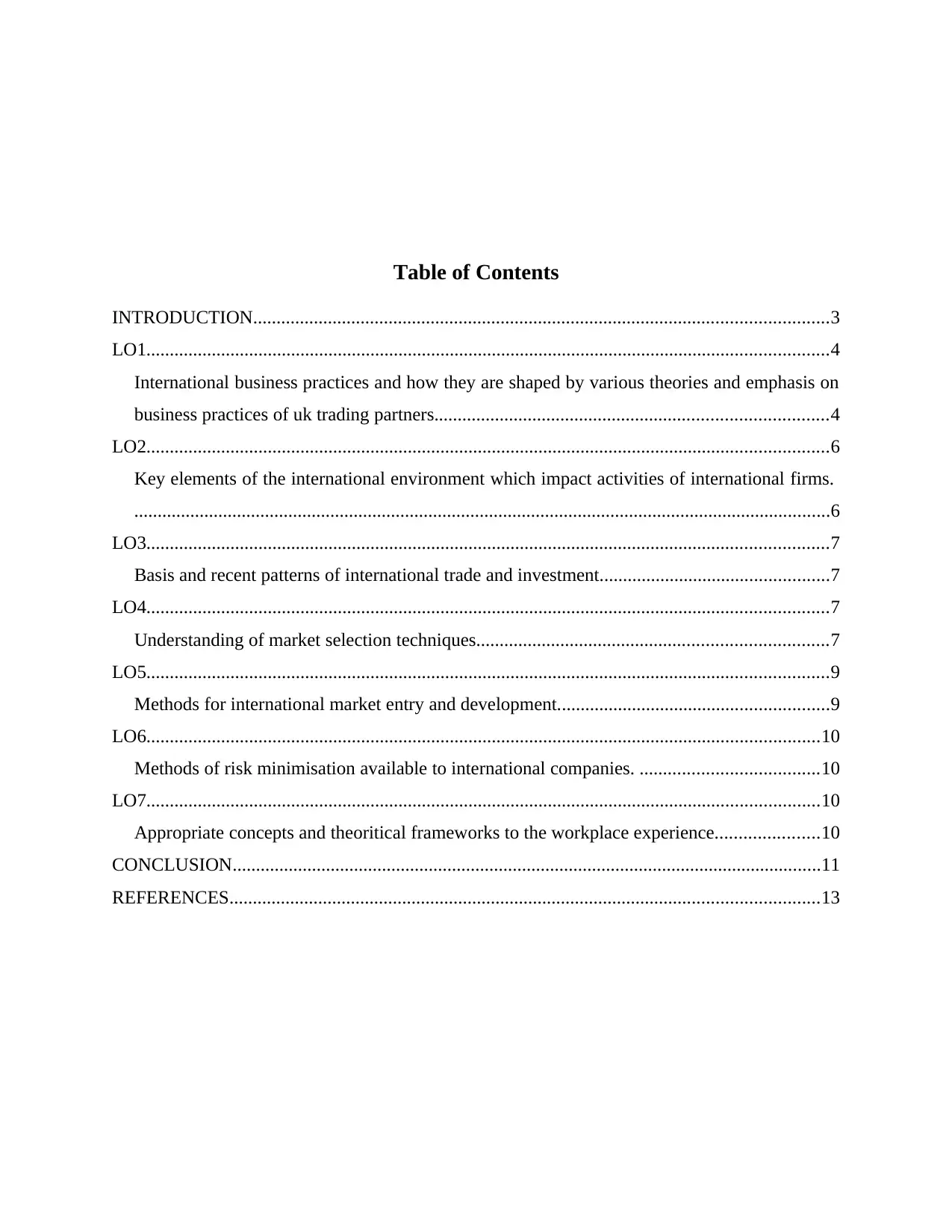
Table of Contents
INTRODUCTION...........................................................................................................................3
LO1..................................................................................................................................................4
International business practices and how they are shaped by various theories and emphasis on
business practices of uk trading partners....................................................................................4
LO2..................................................................................................................................................6
Key elements of the international environment which impact activities of international firms.
.....................................................................................................................................................6
LO3..................................................................................................................................................7
Basis and recent patterns of international trade and investment.................................................7
LO4..................................................................................................................................................7
Understanding of market selection techniques...........................................................................7
LO5..................................................................................................................................................9
Methods for international market entry and development..........................................................9
LO6................................................................................................................................................10
Methods of risk minimisation available to international companies. ......................................10
LO7................................................................................................................................................10
Appropriate concepts and theoritical frameworks to the workplace experience......................10
CONCLUSION..............................................................................................................................11
REFERENCES..............................................................................................................................13
INTRODUCTION...........................................................................................................................3
LO1..................................................................................................................................................4
International business practices and how they are shaped by various theories and emphasis on
business practices of uk trading partners....................................................................................4
LO2..................................................................................................................................................6
Key elements of the international environment which impact activities of international firms.
.....................................................................................................................................................6
LO3..................................................................................................................................................7
Basis and recent patterns of international trade and investment.................................................7
LO4..................................................................................................................................................7
Understanding of market selection techniques...........................................................................7
LO5..................................................................................................................................................9
Methods for international market entry and development..........................................................9
LO6................................................................................................................................................10
Methods of risk minimisation available to international companies. ......................................10
LO7................................................................................................................................................10
Appropriate concepts and theoritical frameworks to the workplace experience......................10
CONCLUSION..............................................................................................................................11
REFERENCES..............................................................................................................................13
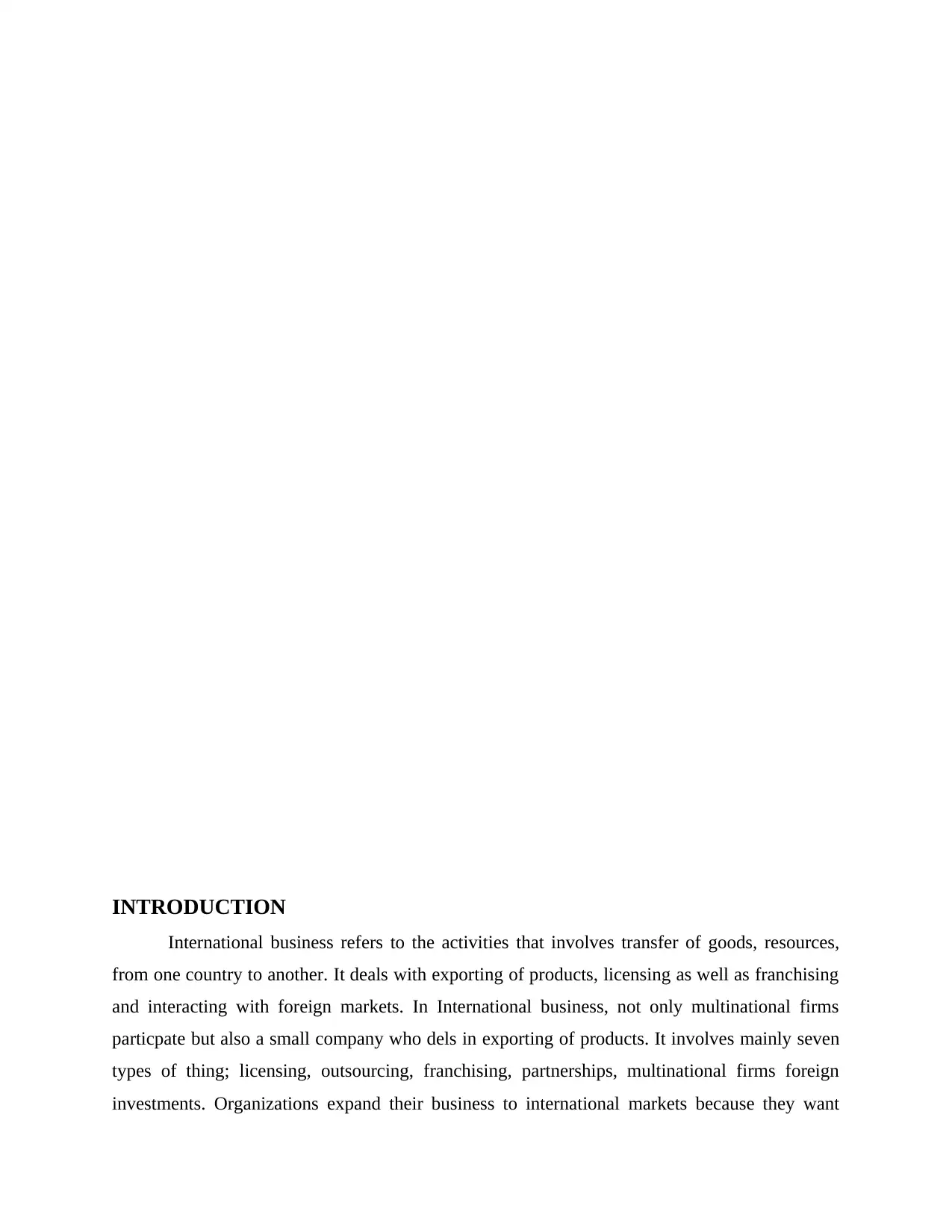
INTRODUCTION
International business refers to the activities that involves transfer of goods, resources,
from one country to another. It deals with exporting of products, licensing as well as franchising
and interacting with foreign markets. In International business, not only multinational firms
particpate but also a small company who dels in exporting of products. It involves mainly seven
types of thing; licensing, outsourcing, franchising, partnerships, multinational firms foreign
investments. Organizations expand their business to international markets because they want
International business refers to the activities that involves transfer of goods, resources,
from one country to another. It deals with exporting of products, licensing as well as franchising
and interacting with foreign markets. In International business, not only multinational firms
particpate but also a small company who dels in exporting of products. It involves mainly seven
types of thing; licensing, outsourcing, franchising, partnerships, multinational firms foreign
investments. Organizations expand their business to international markets because they want
⊘ This is a preview!⊘
Do you want full access?
Subscribe today to unlock all pages.

Trusted by 1+ million students worldwide
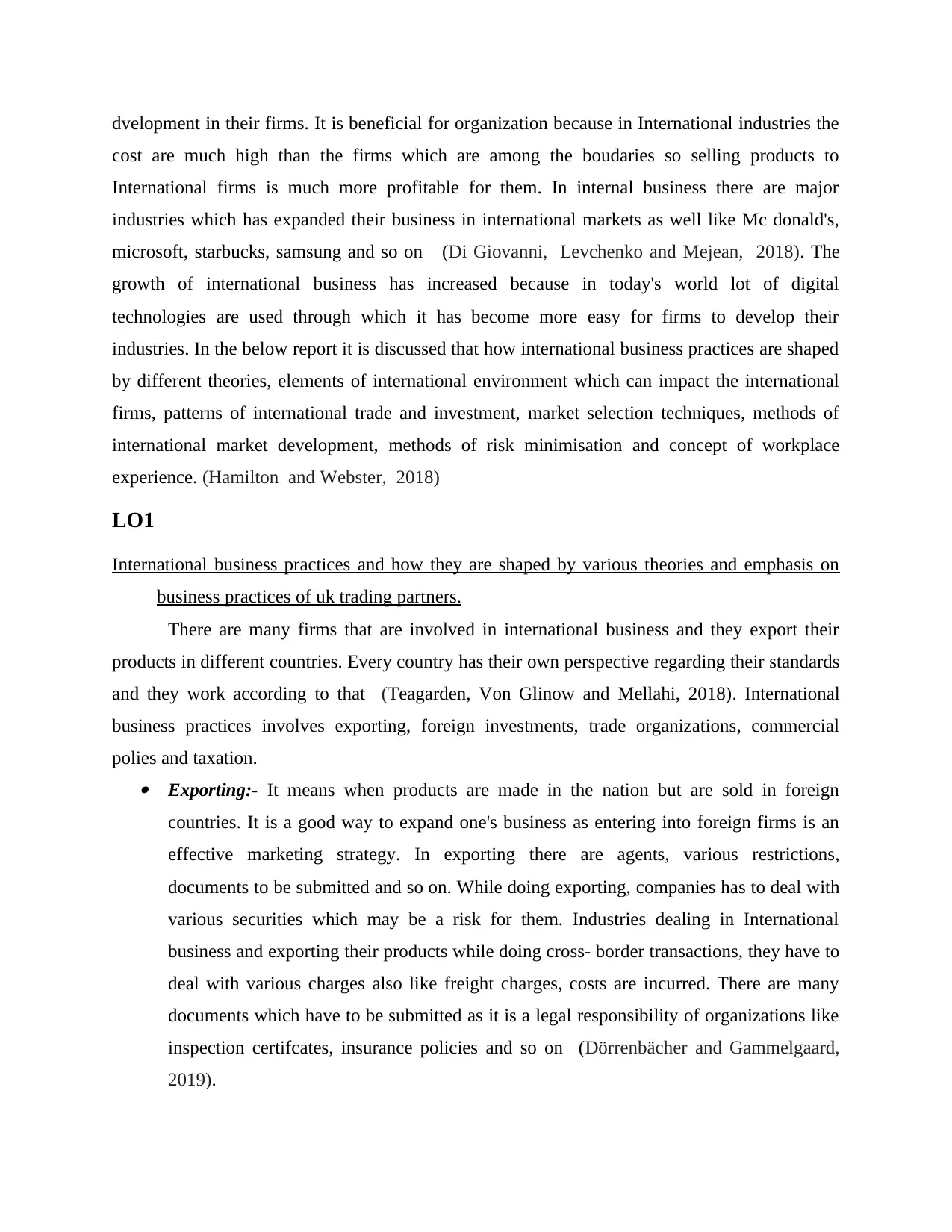
dvelopment in their firms. It is beneficial for organization because in International industries the
cost are much high than the firms which are among the boudaries so selling products to
International firms is much more profitable for them. In internal business there are major
industries which has expanded their business in international markets as well like Mc donald's,
microsoft, starbucks, samsung and so on (Di Giovanni, Levchenko and Mejean, 2018). The
growth of international business has increased because in today's world lot of digital
technologies are used through which it has become more easy for firms to develop their
industries. In the below report it is discussed that how international business practices are shaped
by different theories, elements of international environment which can impact the international
firms, patterns of international trade and investment, market selection techniques, methods of
international market development, methods of risk minimisation and concept of workplace
experience. (Hamilton and Webster, 2018)
LO1
International business practices and how they are shaped by various theories and emphasis on
business practices of uk trading partners.
There are many firms that are involved in international business and they export their
products in different countries. Every country has their own perspective regarding their standards
and they work according to that (Teagarden, Von Glinow and Mellahi, 2018). International
business practices involves exporting, foreign investments, trade organizations, commercial
polies and taxation. Exporting:- It means when products are made in the nation but are sold in foreign
countries. It is a good way to expand one's business as entering into foreign firms is an
effective marketing strategy. In exporting there are agents, various restrictions,
documents to be submitted and so on. While doing exporting, companies has to deal with
various securities which may be a risk for them. Industries dealing in International
business and exporting their products while doing cross- border transactions, they have to
deal with various charges also like freight charges, costs are incurred. There are many
documents which have to be submitted as it is a legal responsibility of organizations like
inspection certifcates, insurance policies and so on (Dörrenbächer and Gammelgaard,
2019).
cost are much high than the firms which are among the boudaries so selling products to
International firms is much more profitable for them. In internal business there are major
industries which has expanded their business in international markets as well like Mc donald's,
microsoft, starbucks, samsung and so on (Di Giovanni, Levchenko and Mejean, 2018). The
growth of international business has increased because in today's world lot of digital
technologies are used through which it has become more easy for firms to develop their
industries. In the below report it is discussed that how international business practices are shaped
by different theories, elements of international environment which can impact the international
firms, patterns of international trade and investment, market selection techniques, methods of
international market development, methods of risk minimisation and concept of workplace
experience. (Hamilton and Webster, 2018)
LO1
International business practices and how they are shaped by various theories and emphasis on
business practices of uk trading partners.
There are many firms that are involved in international business and they export their
products in different countries. Every country has their own perspective regarding their standards
and they work according to that (Teagarden, Von Glinow and Mellahi, 2018). International
business practices involves exporting, foreign investments, trade organizations, commercial
polies and taxation. Exporting:- It means when products are made in the nation but are sold in foreign
countries. It is a good way to expand one's business as entering into foreign firms is an
effective marketing strategy. In exporting there are agents, various restrictions,
documents to be submitted and so on. While doing exporting, companies has to deal with
various securities which may be a risk for them. Industries dealing in International
business and exporting their products while doing cross- border transactions, they have to
deal with various charges also like freight charges, costs are incurred. There are many
documents which have to be submitted as it is a legal responsibility of organizations like
inspection certifcates, insurance policies and so on (Dörrenbächer and Gammelgaard,
2019).
Paraphrase This Document
Need a fresh take? Get an instant paraphrase of this document with our AI Paraphraser

Trade organizations:- It includes corporations, private companies and their branches. To
remain in market, corporations have to fulfill all requirements that are needed. These
organizations helps in exporting of products, importing and running business in a
effective manner. (Cherunilam, 2020) Commercial policies:- These policies are certain rules that gives details regarding how
companies are conducting their international business with other countries. The main
thing which is considered in commercial policy is tariffs as they are applied on selling of
foreign goods across the nation only. Foreign investments:- It means investing in other countries firms. These include some
sort of restrictions also. There are many rights which are given to domestic investors so
same rights are alotted to foreign investors also. (Aguilera, and Grøgaard,2019)
Taxation:- There are mnay things which are involved in taxation like corporate taxes,
personal income taxes and these all taxes are calculated on the basis of net worth.
International business practice are shaped by economic theory, sociao-cultural theory, financial
and political forces.
Economic theory:- Multinational industries are considered and shaped by
economics because it involves investments, production (Fletcher and et.al, 2018).
There are many risks which are included while doing international business as
they borrow capital from other firms, labour are hired and they all have to face
some risks. Economic theory consists of more technical terms.
Socio-cultural forces:- Multinational companies are also shaped by society as
well as culture. They helps in managing all business, producing goods and
whether through doing international business firms are achieving success or
failure. There are many things which are involved in these forces like culture,
religion, language and so on.
Political forces:- International businesses are also shaped by political forces
because government policies may change at any time and due to that the results
may also change. It includes changes in tax rate, corruption, tariffs.
Financial forces:- International business are also shaped by financial forces like
there are some penalties which can affect their business because it leads to their
reputation. Accounting and taxes. (Peterson, Arregle, nd Martin, 2020)
remain in market, corporations have to fulfill all requirements that are needed. These
organizations helps in exporting of products, importing and running business in a
effective manner. (Cherunilam, 2020) Commercial policies:- These policies are certain rules that gives details regarding how
companies are conducting their international business with other countries. The main
thing which is considered in commercial policy is tariffs as they are applied on selling of
foreign goods across the nation only. Foreign investments:- It means investing in other countries firms. These include some
sort of restrictions also. There are many rights which are given to domestic investors so
same rights are alotted to foreign investors also. (Aguilera, and Grøgaard,2019)
Taxation:- There are mnay things which are involved in taxation like corporate taxes,
personal income taxes and these all taxes are calculated on the basis of net worth.
International business practice are shaped by economic theory, sociao-cultural theory, financial
and political forces.
Economic theory:- Multinational industries are considered and shaped by
economics because it involves investments, production (Fletcher and et.al, 2018).
There are many risks which are included while doing international business as
they borrow capital from other firms, labour are hired and they all have to face
some risks. Economic theory consists of more technical terms.
Socio-cultural forces:- Multinational companies are also shaped by society as
well as culture. They helps in managing all business, producing goods and
whether through doing international business firms are achieving success or
failure. There are many things which are involved in these forces like culture,
religion, language and so on.
Political forces:- International businesses are also shaped by political forces
because government policies may change at any time and due to that the results
may also change. It includes changes in tax rate, corruption, tariffs.
Financial forces:- International business are also shaped by financial forces like
there are some penalties which can affect their business because it leads to their
reputation. Accounting and taxes. (Peterson, Arregle, nd Martin, 2020)
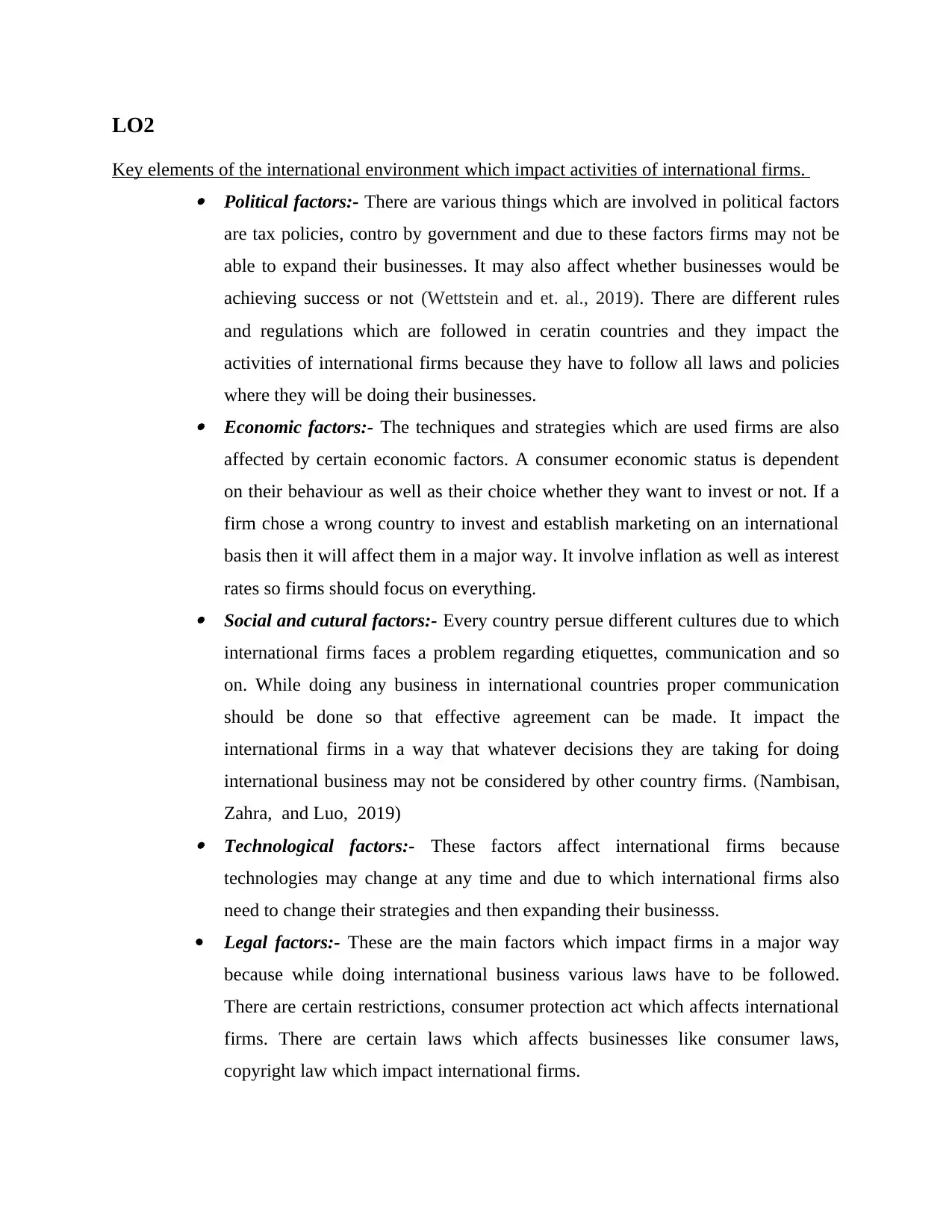
LO2
Key elements of the international environment which impact activities of international firms.
Political factors:- There are various things which are involved in political factors
are tax policies, contro by government and due to these factors firms may not be
able to expand their businesses. It may also affect whether businesses would be
achieving success or not (Wettstein and et. al., 2019). There are different rules
and regulations which are followed in ceratin countries and they impact the
activities of international firms because they have to follow all laws and policies
where they will be doing their businesses.
Economic factors:- The techniques and strategies which are used firms are also
affected by certain economic factors. A consumer economic status is dependent
on their behaviour as well as their choice whether they want to invest or not. If a
firm chose a wrong country to invest and establish marketing on an international
basis then it will affect them in a major way. It involve inflation as well as interest
rates so firms should focus on everything.
Social and cutural factors:- Every country persue different cultures due to which
international firms faces a problem regarding etiquettes, communication and so
on. While doing any business in international countries proper communication
should be done so that effective agreement can be made. It impact the
international firms in a way that whatever decisions they are taking for doing
international business may not be considered by other country firms. (Nambisan,
Zahra, and Luo, 2019)
Technological factors:- These factors affect international firms because
technologies may change at any time and due to which international firms also
need to change their strategies and then expanding their businesss.
Legal factors:- These are the main factors which impact firms in a major way
because while doing international business various laws have to be followed.
There are certain restrictions, consumer protection act which affects international
firms. There are certain laws which affects businesses like consumer laws,
copyright law which impact international firms.
Key elements of the international environment which impact activities of international firms.
Political factors:- There are various things which are involved in political factors
are tax policies, contro by government and due to these factors firms may not be
able to expand their businesses. It may also affect whether businesses would be
achieving success or not (Wettstein and et. al., 2019). There are different rules
and regulations which are followed in ceratin countries and they impact the
activities of international firms because they have to follow all laws and policies
where they will be doing their businesses.
Economic factors:- The techniques and strategies which are used firms are also
affected by certain economic factors. A consumer economic status is dependent
on their behaviour as well as their choice whether they want to invest or not. If a
firm chose a wrong country to invest and establish marketing on an international
basis then it will affect them in a major way. It involve inflation as well as interest
rates so firms should focus on everything.
Social and cutural factors:- Every country persue different cultures due to which
international firms faces a problem regarding etiquettes, communication and so
on. While doing any business in international countries proper communication
should be done so that effective agreement can be made. It impact the
international firms in a way that whatever decisions they are taking for doing
international business may not be considered by other country firms. (Nambisan,
Zahra, and Luo, 2019)
Technological factors:- These factors affect international firms because
technologies may change at any time and due to which international firms also
need to change their strategies and then expanding their businesss.
Legal factors:- These are the main factors which impact firms in a major way
because while doing international business various laws have to be followed.
There are certain restrictions, consumer protection act which affects international
firms. There are certain laws which affects businesses like consumer laws,
copyright law which impact international firms.
⊘ This is a preview!⊘
Do you want full access?
Subscribe today to unlock all pages.

Trusted by 1+ million students worldwide

LO3
Basis and recent patterns of international trade and investment.
According to changing trade patterns, from 1950-1980, trade is controlled by flows
across countries that have high income and accounted to establish high trade barriers. Due to
emerging trade, there are some financial crisis which divides the performance of firms between
high income as well as developin economies. It was analysed that 15 countries faced growth in
exports to 8%. There are certain trade patterns for low as well as middle income countries where
GDP has grown at a good rate. The concept of south-south trade involves growth and expansion
of global production networks. According to north-south trade, in 1980-1990s, countries which
were leading with high income were dominated. There were many changes that occurred like
countries like china implemented various technologies for strong trade practices (Peterson,
Arregle and Martin, 2020). According to Hanson, in 2012, non oil exports were divided into
5categories, agriculture and food, minerals, textiles, metals, machinery. There were many
dynamics for specialization which stated that china manufactured more advanced technology
goods and valued products. Investment as well as trade both have grown at a rapid scale in
context with economic growth. According to the economic growth, both supply and demand are
influenced. In the country if there is slow growth, the prices and earnings decreases due to which
capital also reduces which may help organizations for doing international business. In case of
developed countries, there are many high rate of investments which are done by those investors
and they built their firms within short period of time. In today's world the major foreign
investments which are involved in development of countries are foreign direct investments, joint
ventures. Small firms depend on domestic capital as compared to large multinational firms
because they have access to international financing also.
LO4
Understanding of market selection techniques.
While doing international business a proper market selection should be followed which is
based on different markets. The process of market selection is explained below:- International marketing objectives:- This is the first step while doing international
marketing which refers to find out what the objectives of organization. There are many
objectives that international firms have to achieve and for every goal, different markets
Basis and recent patterns of international trade and investment.
According to changing trade patterns, from 1950-1980, trade is controlled by flows
across countries that have high income and accounted to establish high trade barriers. Due to
emerging trade, there are some financial crisis which divides the performance of firms between
high income as well as developin economies. It was analysed that 15 countries faced growth in
exports to 8%. There are certain trade patterns for low as well as middle income countries where
GDP has grown at a good rate. The concept of south-south trade involves growth and expansion
of global production networks. According to north-south trade, in 1980-1990s, countries which
were leading with high income were dominated. There were many changes that occurred like
countries like china implemented various technologies for strong trade practices (Peterson,
Arregle and Martin, 2020). According to Hanson, in 2012, non oil exports were divided into
5categories, agriculture and food, minerals, textiles, metals, machinery. There were many
dynamics for specialization which stated that china manufactured more advanced technology
goods and valued products. Investment as well as trade both have grown at a rapid scale in
context with economic growth. According to the economic growth, both supply and demand are
influenced. In the country if there is slow growth, the prices and earnings decreases due to which
capital also reduces which may help organizations for doing international business. In case of
developed countries, there are many high rate of investments which are done by those investors
and they built their firms within short period of time. In today's world the major foreign
investments which are involved in development of countries are foreign direct investments, joint
ventures. Small firms depend on domestic capital as compared to large multinational firms
because they have access to international financing also.
LO4
Understanding of market selection techniques.
While doing international business a proper market selection should be followed which is
based on different markets. The process of market selection is explained below:- International marketing objectives:- This is the first step while doing international
marketing which refers to find out what the objectives of organization. There are many
objectives that international firms have to achieve and for every goal, different markets
Paraphrase This Document
Need a fresh take? Get an instant paraphrase of this document with our AI Paraphraser
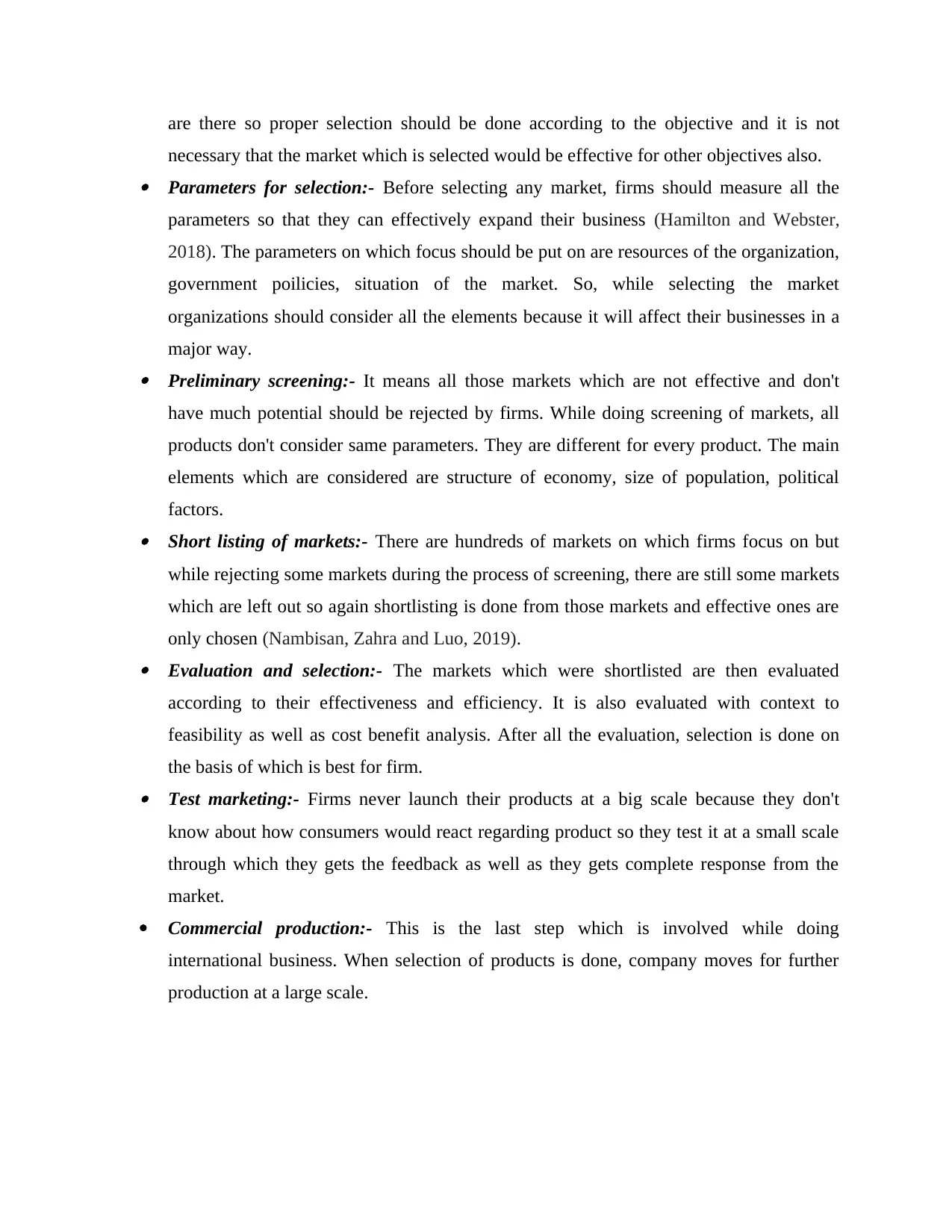
are there so proper selection should be done according to the objective and it is not
necessary that the market which is selected would be effective for other objectives also. Parameters for selection:- Before selecting any market, firms should measure all the
parameters so that they can effectively expand their business (Hamilton and Webster,
2018). The parameters on which focus should be put on are resources of the organization,
government poilicies, situation of the market. So, while selecting the market
organizations should consider all the elements because it will affect their businesses in a
major way. Preliminary screening:- It means all those markets which are not effective and don't
have much potential should be rejected by firms. While doing screening of markets, all
products don't consider same parameters. They are different for every product. The main
elements which are considered are structure of economy, size of population, political
factors. Short listing of markets:- There are hundreds of markets on which firms focus on but
while rejecting some markets during the process of screening, there are still some markets
which are left out so again shortlisting is done from those markets and effective ones are
only chosen (Nambisan, Zahra and Luo, 2019). Evaluation and selection:- The markets which were shortlisted are then evaluated
according to their effectiveness and efficiency. It is also evaluated with context to
feasibility as well as cost benefit analysis. After all the evaluation, selection is done on
the basis of which is best for firm. Test marketing:- Firms never launch their products at a big scale because they don't
know about how consumers would react regarding product so they test it at a small scale
through which they gets the feedback as well as they gets complete response from the
market.
Commercial production:- This is the last step which is involved while doing
international business. When selection of products is done, company moves for further
production at a large scale.
necessary that the market which is selected would be effective for other objectives also. Parameters for selection:- Before selecting any market, firms should measure all the
parameters so that they can effectively expand their business (Hamilton and Webster,
2018). The parameters on which focus should be put on are resources of the organization,
government poilicies, situation of the market. So, while selecting the market
organizations should consider all the elements because it will affect their businesses in a
major way. Preliminary screening:- It means all those markets which are not effective and don't
have much potential should be rejected by firms. While doing screening of markets, all
products don't consider same parameters. They are different for every product. The main
elements which are considered are structure of economy, size of population, political
factors. Short listing of markets:- There are hundreds of markets on which firms focus on but
while rejecting some markets during the process of screening, there are still some markets
which are left out so again shortlisting is done from those markets and effective ones are
only chosen (Nambisan, Zahra and Luo, 2019). Evaluation and selection:- The markets which were shortlisted are then evaluated
according to their effectiveness and efficiency. It is also evaluated with context to
feasibility as well as cost benefit analysis. After all the evaluation, selection is done on
the basis of which is best for firm. Test marketing:- Firms never launch their products at a big scale because they don't
know about how consumers would react regarding product so they test it at a small scale
through which they gets the feedback as well as they gets complete response from the
market.
Commercial production:- This is the last step which is involved while doing
international business. When selection of products is done, company moves for further
production at a large scale.
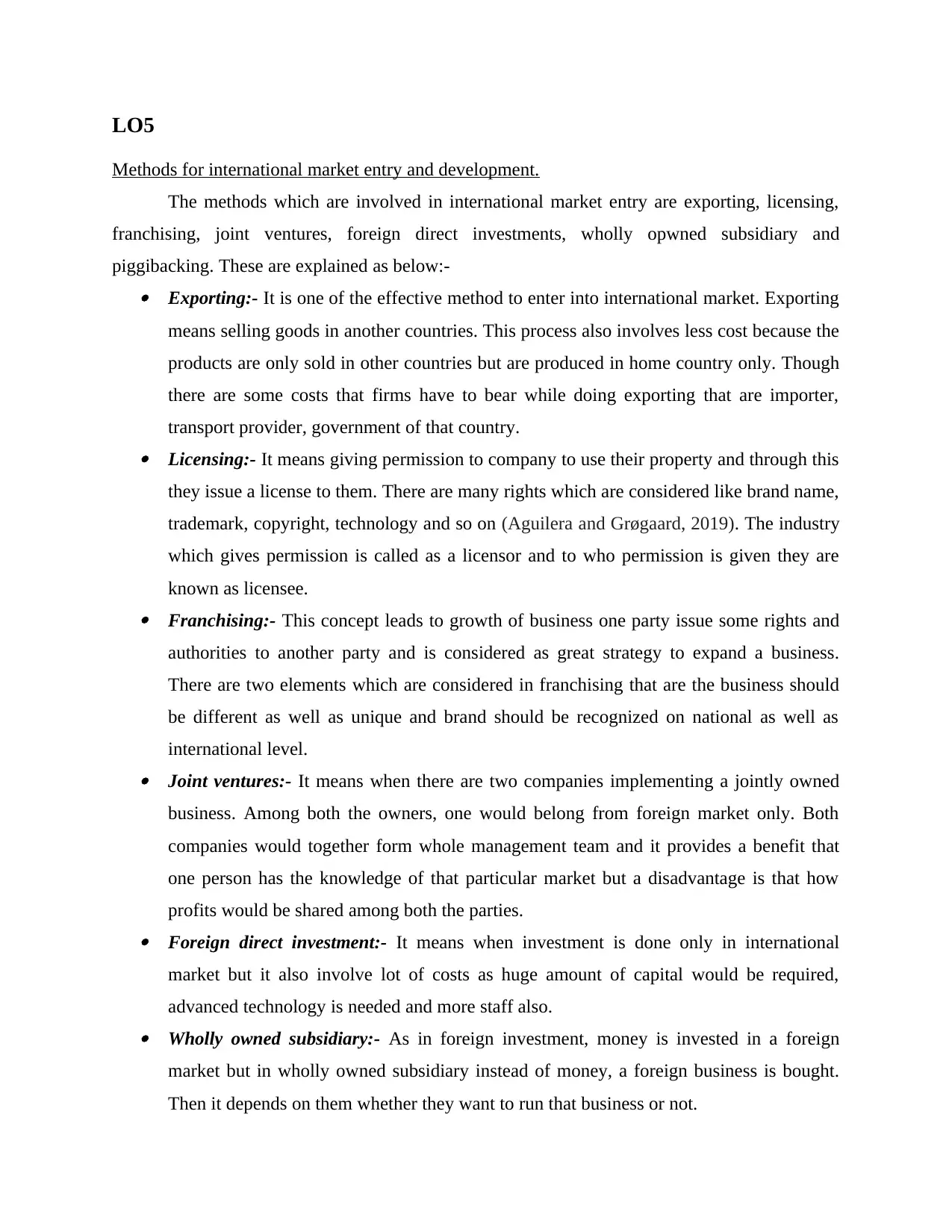
LO5
Methods for international market entry and development.
The methods which are involved in international market entry are exporting, licensing,
franchising, joint ventures, foreign direct investments, wholly opwned subsidiary and
piggibacking. These are explained as below:- Exporting:- It is one of the effective method to enter into international market. Exporting
means selling goods in another countries. This process also involves less cost because the
products are only sold in other countries but are produced in home country only. Though
there are some costs that firms have to bear while doing exporting that are importer,
transport provider, government of that country. Licensing:- It means giving permission to company to use their property and through this
they issue a license to them. There are many rights which are considered like brand name,
trademark, copyright, technology and so on (Aguilera and Grøgaard, 2019). The industry
which gives permission is called as a licensor and to who permission is given they are
known as licensee. Franchising:- This concept leads to growth of business one party issue some rights and
authorities to another party and is considered as great strategy to expand a business.
There are two elements which are considered in franchising that are the business should
be different as well as unique and brand should be recognized on national as well as
international level. Joint ventures:- It means when there are two companies implementing a jointly owned
business. Among both the owners, one would belong from foreign market only. Both
companies would together form whole management team and it provides a benefit that
one person has the knowledge of that particular market but a disadvantage is that how
profits would be shared among both the parties. Foreign direct investment:- It means when investment is done only in international
market but it also involve lot of costs as huge amount of capital would be required,
advanced technology is needed and more staff also. Wholly owned subsidiary:- As in foreign investment, money is invested in a foreign
market but in wholly owned subsidiary instead of money, a foreign business is bought.
Then it depends on them whether they want to run that business or not.
Methods for international market entry and development.
The methods which are involved in international market entry are exporting, licensing,
franchising, joint ventures, foreign direct investments, wholly opwned subsidiary and
piggibacking. These are explained as below:- Exporting:- It is one of the effective method to enter into international market. Exporting
means selling goods in another countries. This process also involves less cost because the
products are only sold in other countries but are produced in home country only. Though
there are some costs that firms have to bear while doing exporting that are importer,
transport provider, government of that country. Licensing:- It means giving permission to company to use their property and through this
they issue a license to them. There are many rights which are considered like brand name,
trademark, copyright, technology and so on (Aguilera and Grøgaard, 2019). The industry
which gives permission is called as a licensor and to who permission is given they are
known as licensee. Franchising:- This concept leads to growth of business one party issue some rights and
authorities to another party and is considered as great strategy to expand a business.
There are two elements which are considered in franchising that are the business should
be different as well as unique and brand should be recognized on national as well as
international level. Joint ventures:- It means when there are two companies implementing a jointly owned
business. Among both the owners, one would belong from foreign market only. Both
companies would together form whole management team and it provides a benefit that
one person has the knowledge of that particular market but a disadvantage is that how
profits would be shared among both the parties. Foreign direct investment:- It means when investment is done only in international
market but it also involve lot of costs as huge amount of capital would be required,
advanced technology is needed and more staff also. Wholly owned subsidiary:- As in foreign investment, money is invested in a foreign
market but in wholly owned subsidiary instead of money, a foreign business is bought.
Then it depends on them whether they want to run that business or not.
⊘ This is a preview!⊘
Do you want full access?
Subscribe today to unlock all pages.

Trusted by 1+ million students worldwide
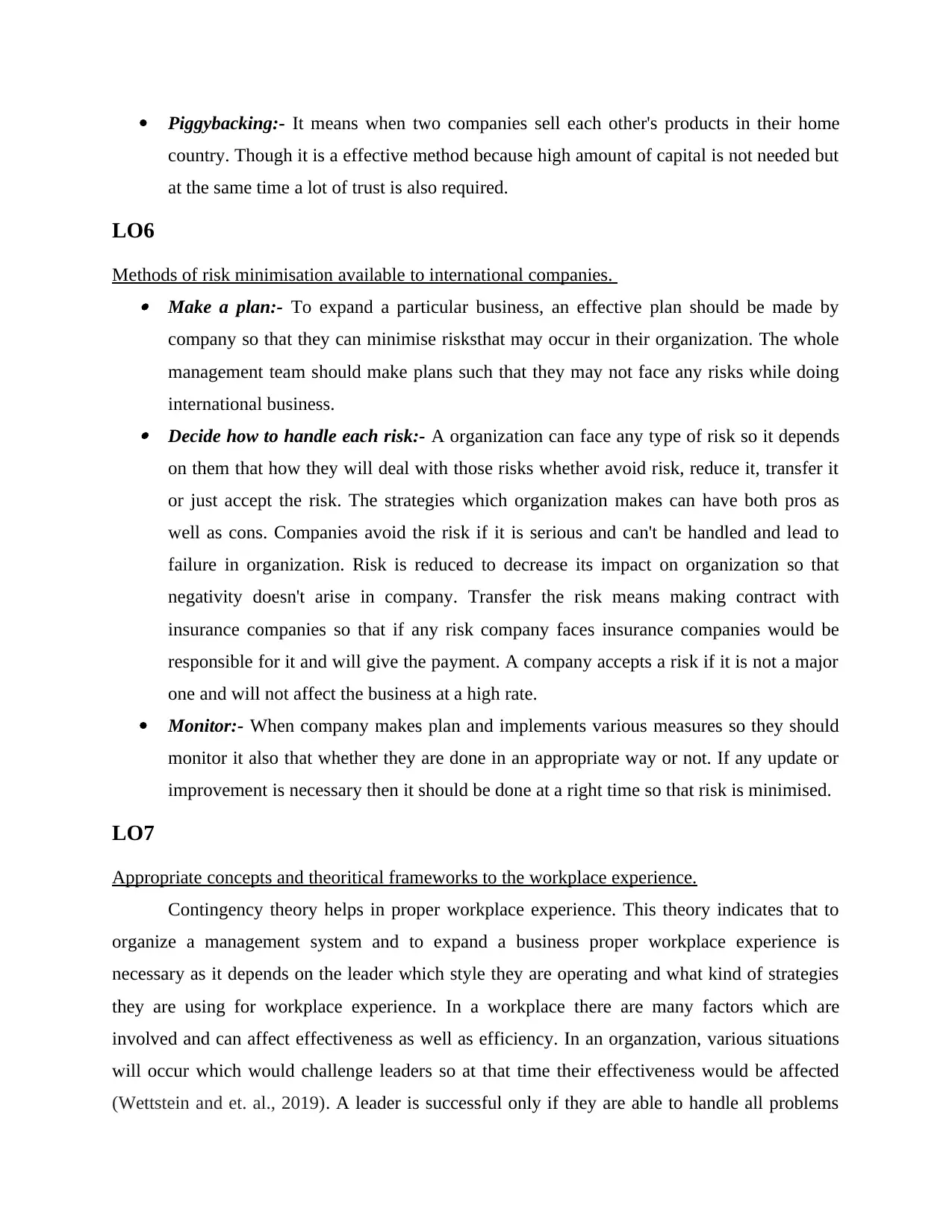
Piggybacking:- It means when two companies sell each other's products in their home
country. Though it is a effective method because high amount of capital is not needed but
at the same time a lot of trust is also required.
LO6
Methods of risk minimisation available to international companies. Make a plan:- To expand a particular business, an effective plan should be made by
company so that they can minimise risksthat may occur in their organization. The whole
management team should make plans such that they may not face any risks while doing
international business. Decide how to handle each risk:- A organization can face any type of risk so it depends
on them that how they will deal with those risks whether avoid risk, reduce it, transfer it
or just accept the risk. The strategies which organization makes can have both pros as
well as cons. Companies avoid the risk if it is serious and can't be handled and lead to
failure in organization. Risk is reduced to decrease its impact on organization so that
negativity doesn't arise in company. Transfer the risk means making contract with
insurance companies so that if any risk company faces insurance companies would be
responsible for it and will give the payment. A company accepts a risk if it is not a major
one and will not affect the business at a high rate.
Monitor:- When company makes plan and implements various measures so they should
monitor it also that whether they are done in an appropriate way or not. If any update or
improvement is necessary then it should be done at a right time so that risk is minimised.
LO7
Appropriate concepts and theoritical frameworks to the workplace experience.
Contingency theory helps in proper workplace experience. This theory indicates that to
organize a management system and to expand a business proper workplace experience is
necessary as it depends on the leader which style they are operating and what kind of strategies
they are using for workplace experience. In a workplace there are many factors which are
involved and can affect effectiveness as well as efficiency. In an organzation, various situations
will occur which would challenge leaders so at that time their effectiveness would be affected
(Wettstein and et. al., 2019). A leader is successful only if they are able to handle all problems
country. Though it is a effective method because high amount of capital is not needed but
at the same time a lot of trust is also required.
LO6
Methods of risk minimisation available to international companies. Make a plan:- To expand a particular business, an effective plan should be made by
company so that they can minimise risksthat may occur in their organization. The whole
management team should make plans such that they may not face any risks while doing
international business. Decide how to handle each risk:- A organization can face any type of risk so it depends
on them that how they will deal with those risks whether avoid risk, reduce it, transfer it
or just accept the risk. The strategies which organization makes can have both pros as
well as cons. Companies avoid the risk if it is serious and can't be handled and lead to
failure in organization. Risk is reduced to decrease its impact on organization so that
negativity doesn't arise in company. Transfer the risk means making contract with
insurance companies so that if any risk company faces insurance companies would be
responsible for it and will give the payment. A company accepts a risk if it is not a major
one and will not affect the business at a high rate.
Monitor:- When company makes plan and implements various measures so they should
monitor it also that whether they are done in an appropriate way or not. If any update or
improvement is necessary then it should be done at a right time so that risk is minimised.
LO7
Appropriate concepts and theoritical frameworks to the workplace experience.
Contingency theory helps in proper workplace experience. This theory indicates that to
organize a management system and to expand a business proper workplace experience is
necessary as it depends on the leader which style they are operating and what kind of strategies
they are using for workplace experience. In a workplace there are many factors which are
involved and can affect effectiveness as well as efficiency. In an organzation, various situations
will occur which would challenge leaders so at that time their effectiveness would be affected
(Wettstein and et. al., 2019). A leader is successful only if they are able to handle all problems
Paraphrase This Document
Need a fresh take? Get an instant paraphrase of this document with our AI Paraphraser
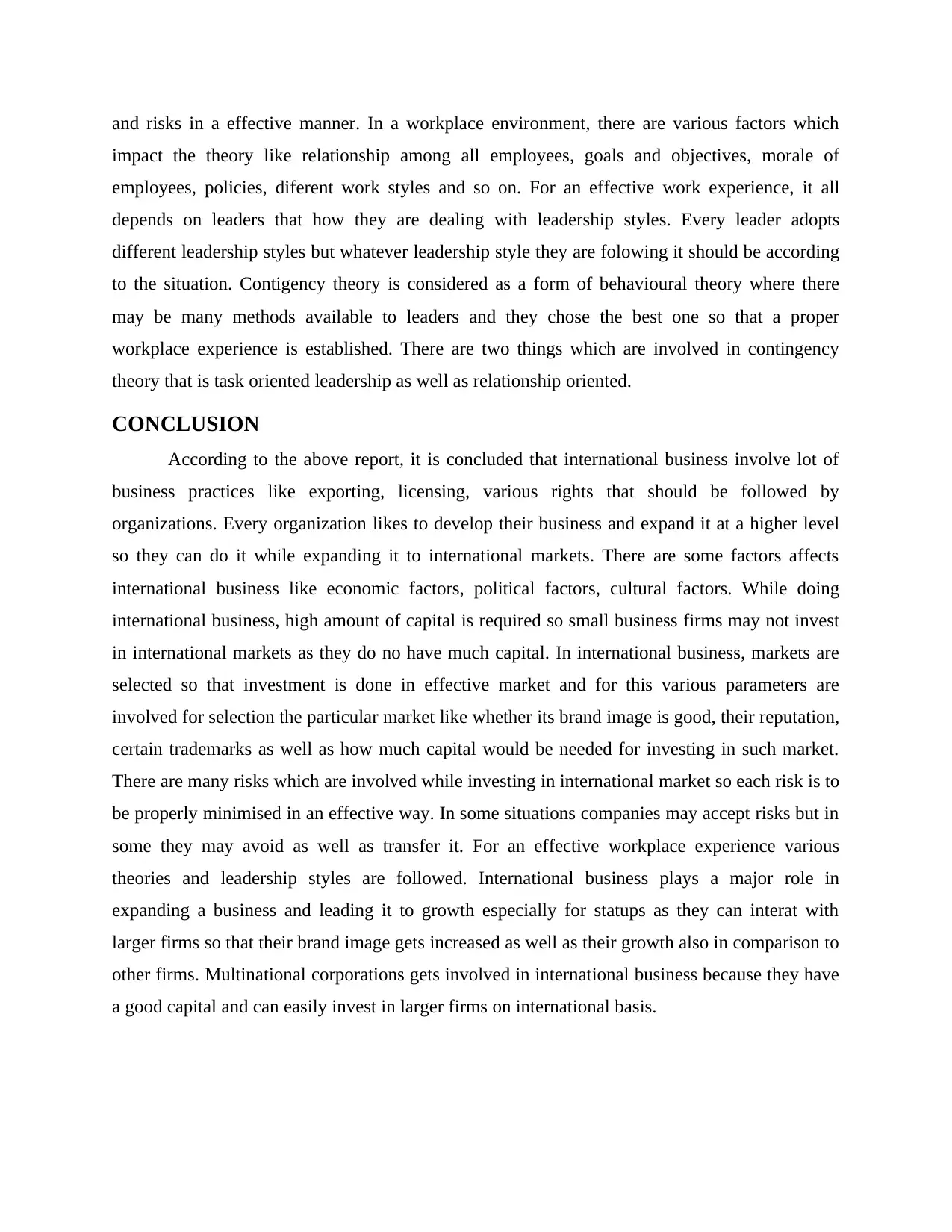
and risks in a effective manner. In a workplace environment, there are various factors which
impact the theory like relationship among all employees, goals and objectives, morale of
employees, policies, diferent work styles and so on. For an effective work experience, it all
depends on leaders that how they are dealing with leadership styles. Every leader adopts
different leadership styles but whatever leadership style they are folowing it should be according
to the situation. Contigency theory is considered as a form of behavioural theory where there
may be many methods available to leaders and they chose the best one so that a proper
workplace experience is established. There are two things which are involved in contingency
theory that is task oriented leadership as well as relationship oriented.
CONCLUSION
According to the above report, it is concluded that international business involve lot of
business practices like exporting, licensing, various rights that should be followed by
organizations. Every organization likes to develop their business and expand it at a higher level
so they can do it while expanding it to international markets. There are some factors affects
international business like economic factors, political factors, cultural factors. While doing
international business, high amount of capital is required so small business firms may not invest
in international markets as they do no have much capital. In international business, markets are
selected so that investment is done in effective market and for this various parameters are
involved for selection the particular market like whether its brand image is good, their reputation,
certain trademarks as well as how much capital would be needed for investing in such market.
There are many risks which are involved while investing in international market so each risk is to
be properly minimised in an effective way. In some situations companies may accept risks but in
some they may avoid as well as transfer it. For an effective workplace experience various
theories and leadership styles are followed. International business plays a major role in
expanding a business and leading it to growth especially for statups as they can interat with
larger firms so that their brand image gets increased as well as their growth also in comparison to
other firms. Multinational corporations gets involved in international business because they have
a good capital and can easily invest in larger firms on international basis.
impact the theory like relationship among all employees, goals and objectives, morale of
employees, policies, diferent work styles and so on. For an effective work experience, it all
depends on leaders that how they are dealing with leadership styles. Every leader adopts
different leadership styles but whatever leadership style they are folowing it should be according
to the situation. Contigency theory is considered as a form of behavioural theory where there
may be many methods available to leaders and they chose the best one so that a proper
workplace experience is established. There are two things which are involved in contingency
theory that is task oriented leadership as well as relationship oriented.
CONCLUSION
According to the above report, it is concluded that international business involve lot of
business practices like exporting, licensing, various rights that should be followed by
organizations. Every organization likes to develop their business and expand it at a higher level
so they can do it while expanding it to international markets. There are some factors affects
international business like economic factors, political factors, cultural factors. While doing
international business, high amount of capital is required so small business firms may not invest
in international markets as they do no have much capital. In international business, markets are
selected so that investment is done in effective market and for this various parameters are
involved for selection the particular market like whether its brand image is good, their reputation,
certain trademarks as well as how much capital would be needed for investing in such market.
There are many risks which are involved while investing in international market so each risk is to
be properly minimised in an effective way. In some situations companies may accept risks but in
some they may avoid as well as transfer it. For an effective workplace experience various
theories and leadership styles are followed. International business plays a major role in
expanding a business and leading it to growth especially for statups as they can interat with
larger firms so that their brand image gets increased as well as their growth also in comparison to
other firms. Multinational corporations gets involved in international business because they have
a good capital and can easily invest in larger firms on international basis.

⊘ This is a preview!⊘
Do you want full access?
Subscribe today to unlock all pages.

Trusted by 1+ million students worldwide
1 out of 15
Related Documents
Your All-in-One AI-Powered Toolkit for Academic Success.
+13062052269
info@desklib.com
Available 24*7 on WhatsApp / Email
![[object Object]](/_next/static/media/star-bottom.7253800d.svg)
Unlock your academic potential
Copyright © 2020–2025 A2Z Services. All Rights Reserved. Developed and managed by ZUCOL.





